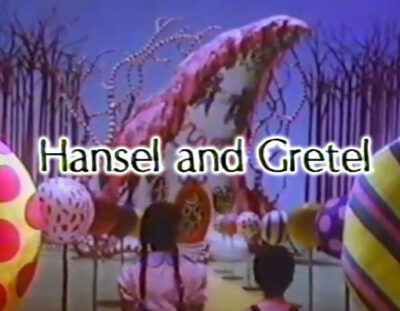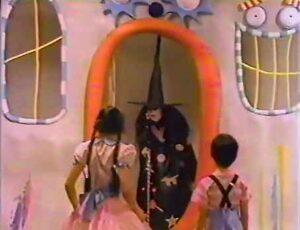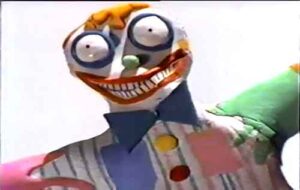At 10:30 PM on Halloween night, 1983, the Disney Channel premiered this “surprisingly scary twist” (so claimed the October ‘83 issue of THE DISNEY CHANNEL MAGAZINE) on the Grimms’ “Hansel and Gretel,” designed and directed by a 25-year-old wunderkind named Tim Burton. Employed as a conceptual artist at the mouse factory, Burton, who had previously made the well-received short VINCENT (1982), convinced Disney’s honchos to back the $116,000 HANSEL AND GRETEL because of his illustrative talents: “I had a bunch of drawings and they let me do it. Everything, especially early on, was based on drawings.”
Hansel and Gretel (Full film)
The 35-minute film was made with an amateur cast and crewmembers that included technical director Stephen Chiodo (of KILLER KLOWNS FROM OUTER SPACE) and model assistant Catherine Hardwicke (the future director of TWILIGHT). Ratings info for HANSEL AND GRETEL is unavailable, but what we do know is that it was never shown again after its initial airing, and got completely overshadowed by Burton’s subsequent short FRANKENWEENIE (1984).
Frankenweenie (Trailer)
The title characters, like everyone else in this film, are Japanese American (because, according to Burton, “I have always been drawn to the Japanese sense of design”). Hansel (Andy Lee) and Gretel (Alison Hong) reside in a plainly artificial universe of cartoony props and indistinct backgrounds, lorded over by their sweet-natured toymaker father (Jim Ishida) and wicked stepmother (the very male Michael Yama). One morning, after locking the kids in the attic (reachable by a VERY tall ladder), the stepmother leads Hansel and Gretel into the forest and abandons them.
VINCENT (Full film)
The kids find their way back, much to their stepmother’s dismay, so she initiates a second forest walk and once again abandons them. This time they find their way to a giant gingerbread house with windows that appear to have eyes and teeth. Living in this fully edible house is a candy cane nosed witch (Michael Yama, again), who gorges the kids on candy and cake, and puts them to sleep in marshmallow beds—from which striped hands emerge from the bedding. Eventually Hansel grows fed up with all the weirdness and, together with Gretel, destroys the house and its inhabitants.
This film demonstrates Burton had yet to reach full maturation as a filmmaker, but that his design sense was fully developed. The candy-colored universe on display, utilizing nearly every form of special effect available in 1983—stop motion, rear projection, superimposition, etc.—contains costumes, scenery and creatures that are now recognizable as Burtonesque. There’s also some authentically disquieting imagery that could only come from the mind of Tim Burton, including a partially eaten gingerbread man begging to be fully devoured and a disintegrating candy house spewing multi-colored goo. Equally recognizable is the funny-scary tone we’ve come to associate with Burton’s films.
The one major drawback is the John Costa score, consisting of lounge-like piano and tinkling bell muzak that’s better suited to MR. ROGERS’ NEIGHBORHOOD.
Vital Statistics
HANSEL AND GRETEL
Burton & Heinrichs Productions
Director: Tim Burton
Producer: Rick Heinrichs
Screenplay: Julie Hickson
Cinematography: Victor Abdalov
Editing: Paul Dougherty
Cast: Michael Yama, Andy Lee, Alison Hong, Jim Ishida, David Koenigsberg



